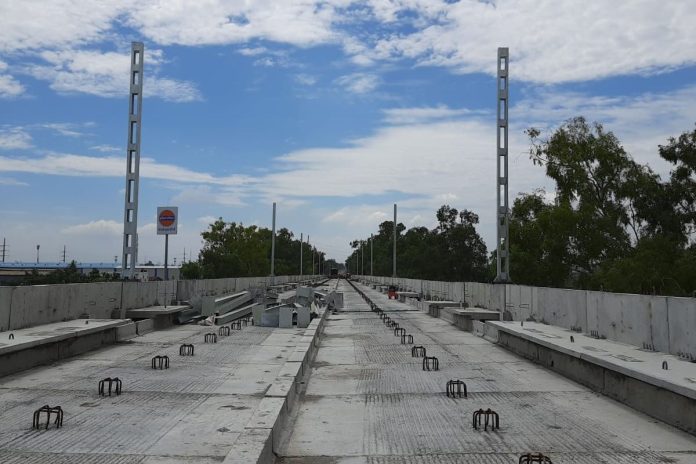Snapshot
Installation of overhead equipment on the viaduct of the 82-km long Delhi-Ghaziabad-Meerut section of RRTS corridor has begun amid precaution.
Stepping up the construction of India’s first rapid rail corridor, installation of overhead equipment (OHE) on the viaduct in the priority section of the 82-km long Delhi-Ghaziabad-Meerut RRTS corridor has begun.
OHE are those electrical devices which supply electricity to trains, thereby powering them. Being a rail-based transport system powered by electric traction, it will consume 1/5th of the power compared to fossil fuels used by road vehicles.
With the aim to serve as a green and sustainable mode of transportation in the NCR zone, the ambitious RRTS (Regional Rapid Transit System) corridor is likely to become a role model for other corridors.
OHE is a complex device in which the contact and the catenary wires are duly fixed to the mast with the help of cantilever. About 1,000 masts are being erected on the RRTS viaduct in the first phase of OHE installation.
The height of these galvanised iron pillars will range from 6.5 to 8 metres. The entire setup of OHE ensures a continuous and smooth collection of electricity (current) in the trains.
These are being firmly fixed by standing upright on the RRTS viaduct at a certain distance from each other on which the other parts of the OHE will be installed. After mast erection on the viaduct, cantilevers will be installed and then catenary and contact wire will be laid.
For the first time in the country, NCRTC (National Capital Region Transport Corporation) is constructing high-speed and frequency RRTS with a design speed of 180 kmph for which suitable electrical overhead equipment, masts, and other electrical devices have been specially designed and manufactured. This will be an improved version of the 25 kV traction system for elevated section.
The OHE installation process is carried out at a high altitude and various precautions are being taken while working. NCRTC conducts proper security audits before carrying out all these works, and works are executed as per the guidelines of the experts.
After OHE installation, further processing and necessary testing will be done as part of trial runs of the train. The priority section of 17 km between Sahibabad to Duhai is scheduled to be commissioned by 2023 and the full corridor by 2025.
NCRTC is setting up five receiving sub stations (RSS) for power supply in the entire corridor of Delhi-Ghaziabad-Meerut RRTS. An RSS (receiving sub station) is being constructed at Ghaziabad to supply power to the priority section where electricity will be drawn from the grid of UPPTCL (Uttar Pradesh Power Transmission Corporation Limited). The RSS will convert it to 25 kV and 33 kV capacity with the help of transformers thereby ensuring continuous power supply to the RRTS train and station respectively.
Currently with the tireless efforts of 1,100 engineers and more than 11,000 workers on the 82-km long RRTS corridor, about 900 piers of the elevated section with 40 km of foundation and 10 km of viaduct have already been completed, most of which is located in the priority section.
According to NCRTC, such a heavy infrastructure project is being prepared and advanced OHE equipment is being established with utmost care and efficient machines amidst a highly populated region and in the median of Delhi Meerut Road (erstwhile NH-58).
About 16 launching girders are working day and night for the construction of the elevated section of RRTS corridor despite the challenges posed by Covid-19. Under the current circumstances, this is a massive rail-based urban transport infrastructure project that is functional on such a large scale.


